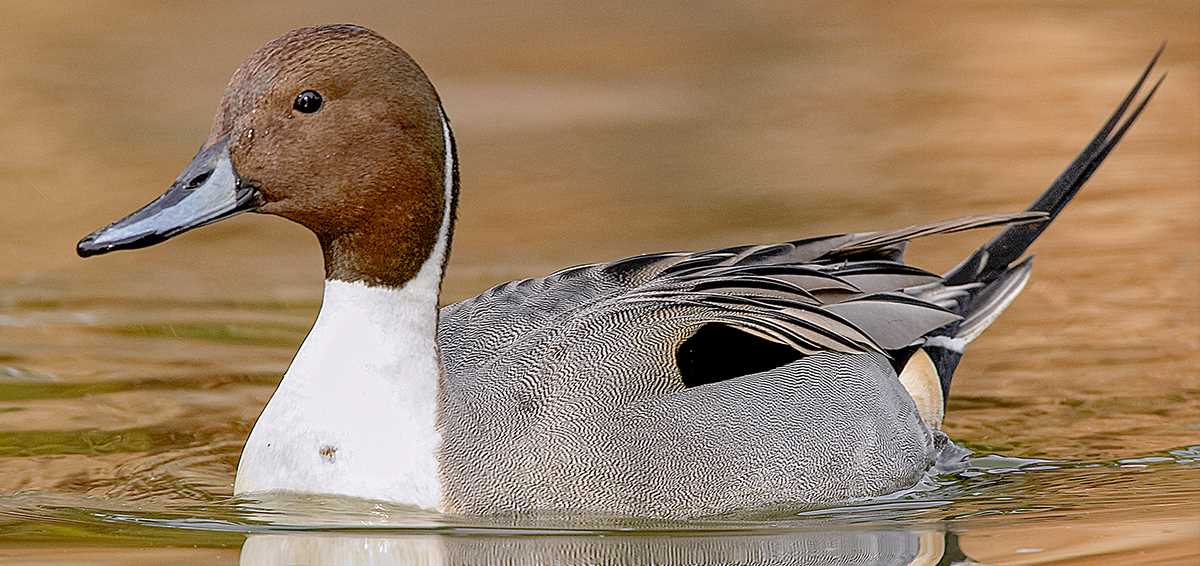Habitat gem a part of pintail strategy

More than 10,000 years ago in southern prairie Canada, retreating glaciers deposited hills of sediment and rock debris. These formed moraines that are riddled with potholes, creating rare jewels of waterfowl habitat and priority conservation areas for Ducks Unlimited. Among these is Alberta's Milk River Ridge, which contains the largest undisturbed fescue prairie in North America. This is the most important waterfowl area in southern Alberta, and it has been actively conserved by DU for the past 18 years.
This area has supported exceptional waterfowl densities exceeding 80 breeding pairs per square mile. Species using ridge habitat in great numbers are pintail, gadwall, shoveler, wigeon, mallard, and blue-winged and cinnamon teal. The area is particularly important to pintails, where densities in some parts of the ridge have reached 20 pairs per square mile. While continental pintail numbers have declined over recent decades, down to 1.8 million from an average of 5.6 million in the 1970s, the habitats of the Milk River Ridge remain prime pintail real estate.
An ongoing Ducks Unlimited study of migrating female pintails has tracked them from their wintering grounds in California to migration and breeding areas. The study highlights the importance of southern Alberta habitats. Ducks Unlimited, the Tuscany Research Institute, the U.S Geological Survey (USGS), and the California Waterfowl Association have been conducting this work together since 2000. Dr. Michael Miller of the USGS is the scientific leader of the project.
"The major thrust of pintail migration into Canada is right through southern Alberta," says Miller. Regardless of their final destination, so many birds travel through southern Alberta that their individual pathways merge into one thick, solid line.
"Certainly that points to how important the Milk River Ridge would be when it's wet and prime," says Miller. "It's so far south in Alberta that it would be the first habitat that they encounter when coming from the south. If it's in good condition, they likely will stop there. In fact, several of our hens equipped with satellite transmitters have used the Milk River Ridge during the course of the research project."
When they do touch down, they receive a warm welcome. For many years, DU has worked to improve pintail habitat in southern Alberta. On the Milk River Ridge, DU has conserved close to 20,000 acres of wetland and upland habitat. Two large cattle ranches operate on the ridge, ensuring that most of the habitat remains uncultivated-a rarity in Canada's southern prairies. However, approximately one-third of the ridge's uplands have been converted to annual cropping.
Grassland loss may be of greater concern to pintails because their nesting preferences are unusual among waterfowl. They prefer sparse nesting cover and will nest in cropland stubble just as readily as they would in short grass. Other duck species prefer to nest in grass or shrub areas that cover and protect nests. As a result of their habitat preferences and their early return to nesting grounds in the spring, pintail hens often establish nests in crop stubble, where they and their nests are at great risk of destruction by farm equipment. Compounding the loss of nests is the fact that pintails are reluctant renesters. If a pintail's nest and eggs are destroyed, the hen may try to renest once or twice, but that's it. Compare this to mallards, which may attempt to renest as many as six times after a nest has been destroyed.
Where possible, DU has restored wetlands and grasslands and worked with local landowners to protect wetlands from grazing cattle. Where no option exists to return cultivated lands to grass cover, DU works with landowners to reduce disturbance on annually cropped uplands.
Wildlife-friendly fall-seeded crops, such as winter wheat and fall rye, give nesting pintails a better chance to hatch out their clutches. DU research has determined that the production of pintails nesting in fall-seeded crops increased 15 to 20 times over those nesting in traditional spring-seeded crops.
In an effort to increase farmers' adoption of winter wheat, DU has strategically placed winter wheat demonstration sites on the Milk River Ridge and teamed this up with a "core grower" program that takes a "show and tell" approach to winter wheat production. Core growers are successful winter wheat growers who convey the benefits of winter wheat to their community.
DU's conservation activities on the Milk River Ridge are a small-scale rollout of a prairiewide, tailor made conservation strategy for pintails. Targeted under this strategy are exceptional areas like Milk River Ridge, which offer excellent habitat, and the far-from-pristine but much more common cultivated uplands where the majority of pintails nest. It is here that DU biologists have researched the challenges facing pintails and, working with pintail experts across North America, identified a plan of action to help improve pintail nesting success. The first objective is to minimize the effects of habitat loss on pintail production.
"We want to focus our research efforts on intensely impacted landscapes so that we can better understand how to return them to productive pintail habitat," says Dr. Karla Guyn, conservation programs biologist with DU Canada. She has spent the past 10 years studying pintails and readily admits the ridge offers the best pintail habitat in southern Alberta, but she's quick to point out it's also very rare habitat.
"Unfortunately, there is only one Milk River Ridge," says Guyn. "To increase pintail populations, we need to work in cultivated landscapes. We have to add habitat, we can't just protect it."
The pintail initiative mirrors DU's existing habitat conservation, restoration, and management programs, but with one crucial exception-efforts are directed toward conserving and restoring habitats particularly important to pintails. A species-specific strategy is a step away from DU's standard conservation philosophy, but biologists are convinced that such a conservation program is warranted.